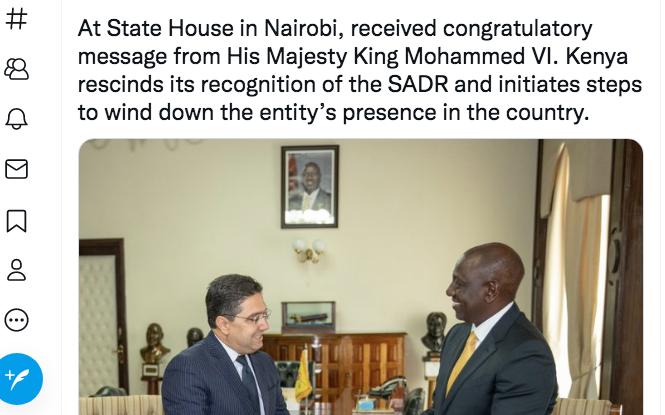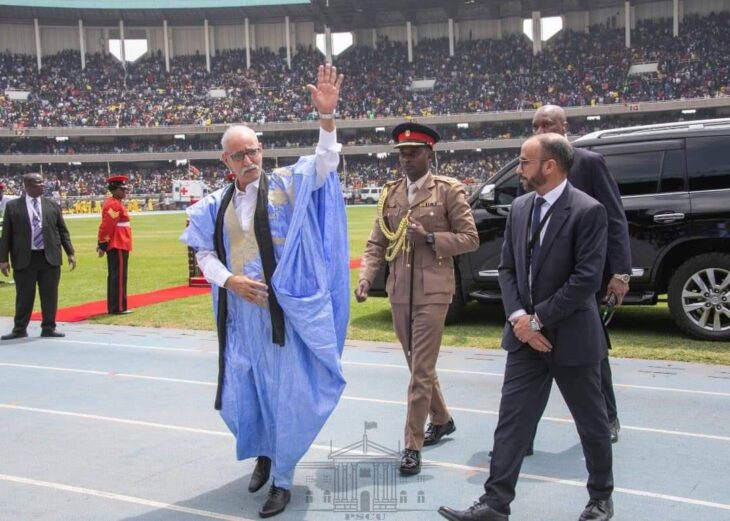NAIROBI, Kenya, Sept, 15 – It was at the inauguration of President William Ruto, shortly after Ugandan President Yoweri Museveni concluded his address, that Ruto returned to the dais, introducing two heads of state whom he failed to acknowledge in his opening remarks.
The first was Sierra Leone President Julius Maada Bio, who Ruto warmly welcomed to the country while the second, only a few at the Moi Kasarani Sports Complex, based on the reception, knew who he was.
Though some might remember him as one of the speakers that gave a tribute to the Late President Daniel Moi during his funeral in 2020.
“With a lot of apology, I have been informed that within our midst we have other friends who I did not mention,…Let me also introduce the president of Sahrawi Republic, his excellency Brahim Ghali,” said Ruto during his inauguration.
Ghali has been the president of the Sahrawi Arab Democratic Republic (SADR) since 2016.
On Wednesday President Ruto in a tweet, revealed that he had rescinded the recognition of the SADR further noting that plans were underway to review their relations.
“Kenya rescinds its recognition of the SADR and initiates steps to wind down the entity’s presence in the country,” read the tweet from Ruto.
The tweet was however shortly after deleted from Ruto’s official Twitter page. The reason behind the move termed by some as a ‘diplomatic faux pas’ remains unclear.

He further said that his administration would support the United Nations Framework as, “the exclusive mechanism to find a lasting solution of the dispute over Western Sahara.”
It is worth noting that president Ghali was received at the Jomo Kenyatta International Airport (JKIA) by ambassador Arthur Andambi ahead of Ruto’s inauguration ceremony.
The communique came hours after the president received a congratulatory message from his Majesty King Mohammed VI, the King of Morocco which was delivered by Moroccan Foreign Minister Nasser Bourita.
“We are accelerating relations with the Kingdom of Morocco in areas of trade, agriculture, health, tourism, and energy, among others, for the mutual benefit of our countries,” said Ruto.
Reports hinted that officials in Rabat were displeased with Ruto’s recognition of the leader and that his utterance, in a global setting gave credence to the legitimacy of an independent Sahrawi state despite contentious issues between the two entities being yet to be determined.
The United Nations does not recognize SADR as an autonomous nation though close to 43 individual member states including the African Union recognize the country as one of its member states.
Morocco on the other hand has laid claim to the territory which is part of the larger Western Sahara region since 1975. It is said to control 80 per cent of the territory while SADR controls 20 per cent.
Kenya’s ‘Support’ For Sahrawi Arab Democratic Republic (SADR) Over The Years
The ties between the two entities go back to the Mwai Kibaki presidency during his first term in office, where the government at the time revealed plans to establish diplomatic ties between the two nations.
Kenya said that its decision was in line with the AU policy to recognize SADR right to self-determination.
“We have established diplomatic relations with them (Western Sahara), this is the first time. They are now free to open their embassy or diplomatic representation here in Kenya, but that does not mean we can do the same there. said then government spokesperson Alfred Mutua.
He further said that it was an extension of what other countries within the African Union had done.
President Kibaki in March 2005 received the credentials of the SADR ambassador though in October the same year the government temporarily ‘froze’ diplomatic relations between the two countries.
In 2014, during former president Uhuru Kenyatta’s first term, the Sahrawi Republic opened its embassy in Nairobi. Noticeably, no government official attended the event though former vice president Kalonzo Musyoka, former deputy speaker of the National Assembly Farah Maalim among other civil society representatives attended the function at the Laico Regency Hotel.
Envoys from Spain, Zimbabwe, South Africa, Algeria, and Zambia were in attendance.
Former Attorney General Professor Githu Muigai had in the past expressed hs reservations over the decision to allow the SADR to open an Embassy in Nairobi.
He argued that recognition in line with the Au’s position did not create an obligation for establishing diplomatic relations and in turn the opening of a diplomatic mission in Kenya.
Earlier this year, while delivering the progress report of the African Union Peace and Security Council (AU-PSC) at the 35th Ordinary Session of the Assembly of Heads of State and Government of the AU, former president Uhuru Kenyatta decried the escalating military tension between the Kingdom of Morocco and Sahrawi Arab Democratic Republic (SADR) despite the various UN and AU resolutions and proposed measures to de-escalate the tension.
“In this regard, the assembly may wish to request the Peace and Security Council to discharge its mandate on the conflict in Western Sahara, in accordance with the relevant provisions of its protocol and the relevant assembly decisions by reviewing the situation in the Western Sahara as necessary, at Heads of State and Government level.
“This should include receiving briefings from the AU Troika; engaging the two parties, both of whom are member states of the AU, to address the unfolding situation in order to prepare conditions for a new ceasefire and to reach a just and durable solution to the conflict,” President Kenyatta proposed
Morocco rejoined the African Union in 2017 after a 33-year absence. It left after the previous incarnation of the Union recognized the independence of Moroccan-occupied Western Sahara.
Colonialism And War In The Region
Western Sahara is a large mineral-rich yet mostly uninhabitable desert. There are abundant reserves of phosphate – a key ingredient in manufacturing synthetic fertilizers, lucrative fish resources, and possibly, offshore oil.
The West-African territory came under Spanish colonial rule in 1884 and in 1934 was turned into a province named Spanish Sahara. Parallel to the developing legal status of Western Sahara, Morocco gained its independence from France in 1956 and only one year later re-asserted its centuries-old claim on the territory.
In 1973, a politico-military movement called the Popular Front for the Liberation of Saguia el-Hamra and Rio de Oro (Polisario Front) emerged, launching a war to win independence for the territory.
Two years later, Spain withdrew, leaving the region to be partitioned between Morocco and Mauritania. One year after that, the Polisario Front started the SADR, based in Tindouf, Algeria, now fighting for independence from two colonial masters.
Three years following this, Mauritania renounced its claims to the territory, which Morocco annexed and has controlled since then.
In 1991, the conflict was halted when United Nations Security Council Resolution (UNSCR 690) was adopted and the “Mission of the United Nations for the Referendum in Western Sahara” (MINURSO) came into being to monitor the cease-fire, with the understanding that a referendum would be held to determine the territory’s future; Independence or integration with Morocco.
Nearly 30 years later this referendum has not yet taken place, primarily due to disagreements as to who is eligible to vote.
Additional Reporting By Human Security Centre.
Want to send us a story? Contact Shahidi News Tel: +254115512797 (Mobile & WhatsApp)


